Toyota's Strategic Resources, Operations, and Value Chain Analysis
VerifiedAdded on 2022/10/04
|15
|3696
|13
Report
AI Summary
This report provides a comprehensive analysis of Toyota's strategic resources and operations, focusing on its supply chain management, value chain analysis, and implementation of a lean system. It begins with an introduction to Toyota's history, its position in the automotive industry, and the business challenges it has faced. The discussion section delves into Toyota's supply chain management, emphasizing the Toyota Production System (TPS) and the importance of capacity planning and inventory management. The report then examines Toyota's corporate and operational strategies, followed by a detailed value chain analysis using Porter's model, including primary and support activities. The lean system section discusses the concept of lean manufacturing, its principles, and its application within Toyota to reduce waste and improve efficiency. Finally, the report addresses Toyota's sustainability efforts throughout its value chain, highlighting supply chain risks and the importance of sustainable practices. The report concludes with a summary of the key findings and insights into Toyota's strategic management.
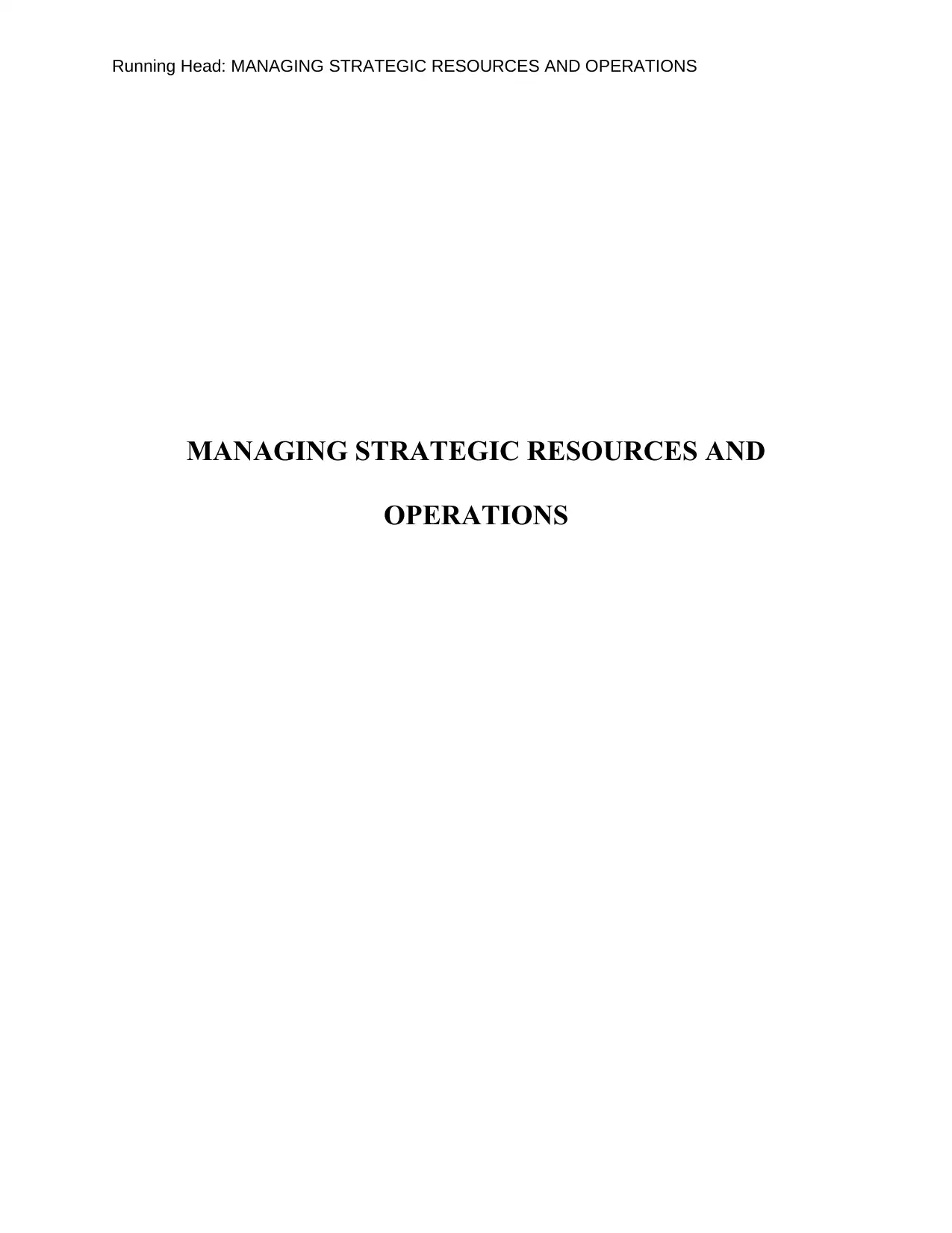
Running Head: MANAGING STRATEGIC RESOURCES AND OPERATIONS
MANAGING STRATEGIC RESOURCES AND
OPERATIONS
MANAGING STRATEGIC RESOURCES AND
OPERATIONS
Paraphrase This Document
Need a fresh take? Get an instant paraphrase of this document with our AI Paraphraser
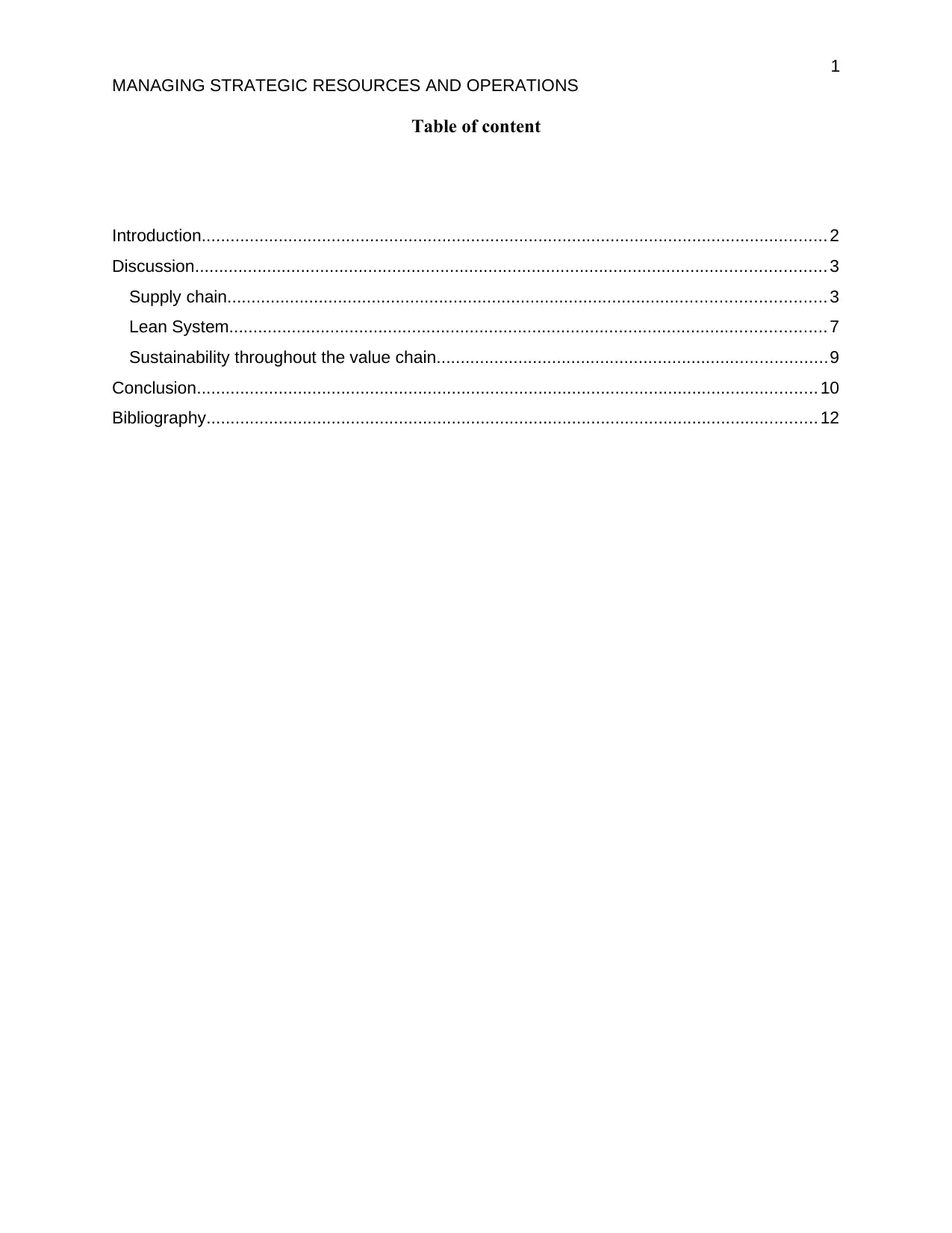
1
MANAGING STRATEGIC RESOURCES AND OPERATIONS
Table of content
Introduction.................................................................................................................................. 2
Discussion................................................................................................................................... 3
Supply chain............................................................................................................................ 3
Lean System............................................................................................................................ 7
Sustainability throughout the value chain.................................................................................9
Conclusion................................................................................................................................. 10
Bibliography............................................................................................................................... 12
MANAGING STRATEGIC RESOURCES AND OPERATIONS
Table of content
Introduction.................................................................................................................................. 2
Discussion................................................................................................................................... 3
Supply chain............................................................................................................................ 3
Lean System............................................................................................................................ 7
Sustainability throughout the value chain.................................................................................9
Conclusion................................................................................................................................. 10
Bibliography............................................................................................................................... 12
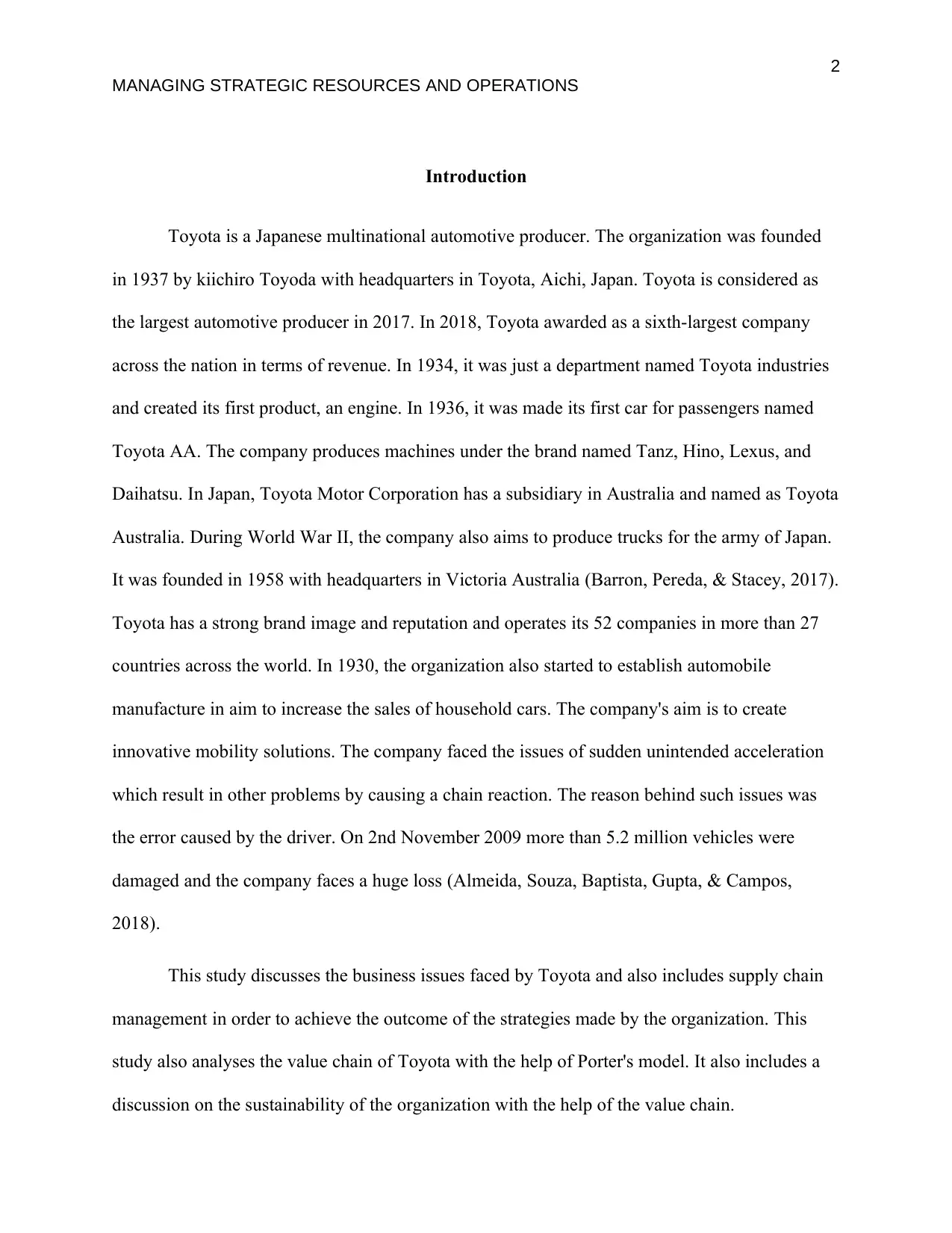
2
MANAGING STRATEGIC RESOURCES AND OPERATIONS
Introduction
Toyota is a Japanese multinational automotive producer. The organization was founded
in 1937 by kiichiro Toyoda with headquarters in Toyota, Aichi, Japan. Toyota is considered as
the largest automotive producer in 2017. In 2018, Toyota awarded as a sixth-largest company
across the nation in terms of revenue. In 1934, it was just a department named Toyota industries
and created its first product, an engine. In 1936, it was made its first car for passengers named
Toyota AA. The company produces machines under the brand named Tanz, Hino, Lexus, and
Daihatsu. In Japan, Toyota Motor Corporation has a subsidiary in Australia and named as Toyota
Australia. During World War II, the company also aims to produce trucks for the army of Japan.
It was founded in 1958 with headquarters in Victoria Australia (Barron, Pereda, & Stacey, 2017).
Toyota has a strong brand image and reputation and operates its 52 companies in more than 27
countries across the world. In 1930, the organization also started to establish automobile
manufacture in aim to increase the sales of household cars. The company's aim is to create
innovative mobility solutions. The company faced the issues of sudden unintended acceleration
which result in other problems by causing a chain reaction. The reason behind such issues was
the error caused by the driver. On 2nd November 2009 more than 5.2 million vehicles were
damaged and the company faces a huge loss (Almeida, Souza, Baptista, Gupta, & Campos,
2018).
This study discusses the business issues faced by Toyota and also includes supply chain
management in order to achieve the outcome of the strategies made by the organization. This
study also analyses the value chain of Toyota with the help of Porter's model. It also includes a
discussion on the sustainability of the organization with the help of the value chain.
MANAGING STRATEGIC RESOURCES AND OPERATIONS
Introduction
Toyota is a Japanese multinational automotive producer. The organization was founded
in 1937 by kiichiro Toyoda with headquarters in Toyota, Aichi, Japan. Toyota is considered as
the largest automotive producer in 2017. In 2018, Toyota awarded as a sixth-largest company
across the nation in terms of revenue. In 1934, it was just a department named Toyota industries
and created its first product, an engine. In 1936, it was made its first car for passengers named
Toyota AA. The company produces machines under the brand named Tanz, Hino, Lexus, and
Daihatsu. In Japan, Toyota Motor Corporation has a subsidiary in Australia and named as Toyota
Australia. During World War II, the company also aims to produce trucks for the army of Japan.
It was founded in 1958 with headquarters in Victoria Australia (Barron, Pereda, & Stacey, 2017).
Toyota has a strong brand image and reputation and operates its 52 companies in more than 27
countries across the world. In 1930, the organization also started to establish automobile
manufacture in aim to increase the sales of household cars. The company's aim is to create
innovative mobility solutions. The company faced the issues of sudden unintended acceleration
which result in other problems by causing a chain reaction. The reason behind such issues was
the error caused by the driver. On 2nd November 2009 more than 5.2 million vehicles were
damaged and the company faces a huge loss (Almeida, Souza, Baptista, Gupta, & Campos,
2018).
This study discusses the business issues faced by Toyota and also includes supply chain
management in order to achieve the outcome of the strategies made by the organization. This
study also analyses the value chain of Toyota with the help of Porter's model. It also includes a
discussion on the sustainability of the organization with the help of the value chain.
⊘ This is a preview!⊘
Do you want full access?
Subscribe today to unlock all pages.

Trusted by 1+ million students worldwide
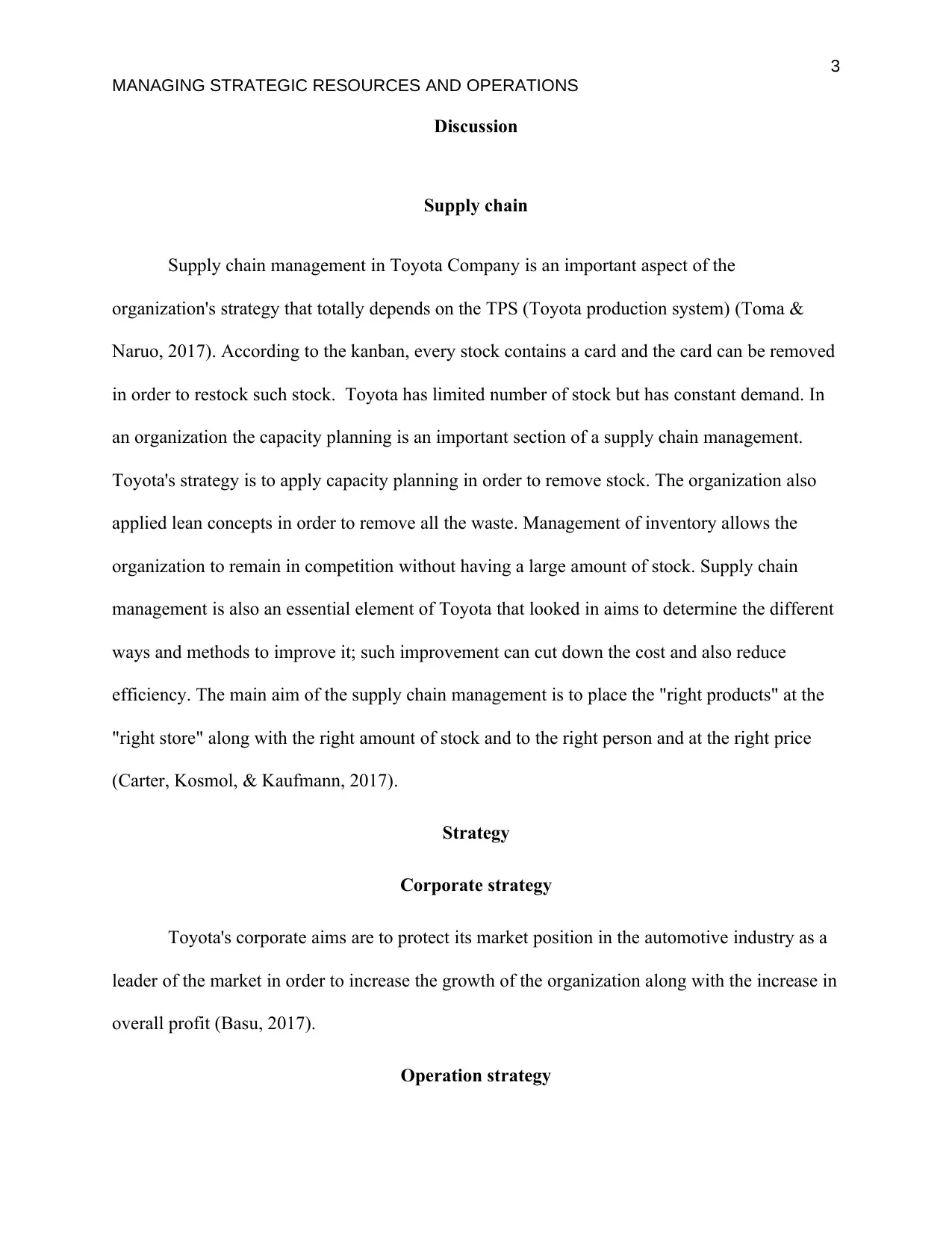
3
MANAGING STRATEGIC RESOURCES AND OPERATIONS
Discussion
Supply chain
Supply chain management in Toyota Company is an important aspect of the
organization's strategy that totally depends on the TPS (Toyota production system) (Toma &
Naruo, 2017). According to the kanban, every stock contains a card and the card can be removed
in order to restock such stock. Toyota has limited number of stock but has constant demand. In
an organization the capacity planning is an important section of a supply chain management.
Toyota's strategy is to apply capacity planning in order to remove stock. The organization also
applied lean concepts in order to remove all the waste. Management of inventory allows the
organization to remain in competition without having a large amount of stock. Supply chain
management is also an essential element of Toyota that looked in aims to determine the different
ways and methods to improve it; such improvement can cut down the cost and also reduce
efficiency. The main aim of the supply chain management is to place the "right products" at the
"right store" along with the right amount of stock and to the right person and at the right price
(Carter, Kosmol, & Kaufmann, 2017).
Strategy
Corporate strategy
Toyota's corporate aims are to protect its market position in the automotive industry as a
leader of the market in order to increase the growth of the organization along with the increase in
overall profit (Basu, 2017).
Operation strategy
MANAGING STRATEGIC RESOURCES AND OPERATIONS
Discussion
Supply chain
Supply chain management in Toyota Company is an important aspect of the
organization's strategy that totally depends on the TPS (Toyota production system) (Toma &
Naruo, 2017). According to the kanban, every stock contains a card and the card can be removed
in order to restock such stock. Toyota has limited number of stock but has constant demand. In
an organization the capacity planning is an important section of a supply chain management.
Toyota's strategy is to apply capacity planning in order to remove stock. The organization also
applied lean concepts in order to remove all the waste. Management of inventory allows the
organization to remain in competition without having a large amount of stock. Supply chain
management is also an essential element of Toyota that looked in aims to determine the different
ways and methods to improve it; such improvement can cut down the cost and also reduce
efficiency. The main aim of the supply chain management is to place the "right products" at the
"right store" along with the right amount of stock and to the right person and at the right price
(Carter, Kosmol, & Kaufmann, 2017).
Strategy
Corporate strategy
Toyota's corporate aims are to protect its market position in the automotive industry as a
leader of the market in order to increase the growth of the organization along with the increase in
overall profit (Basu, 2017).
Operation strategy
Paraphrase This Document
Need a fresh take? Get an instant paraphrase of this document with our AI Paraphraser
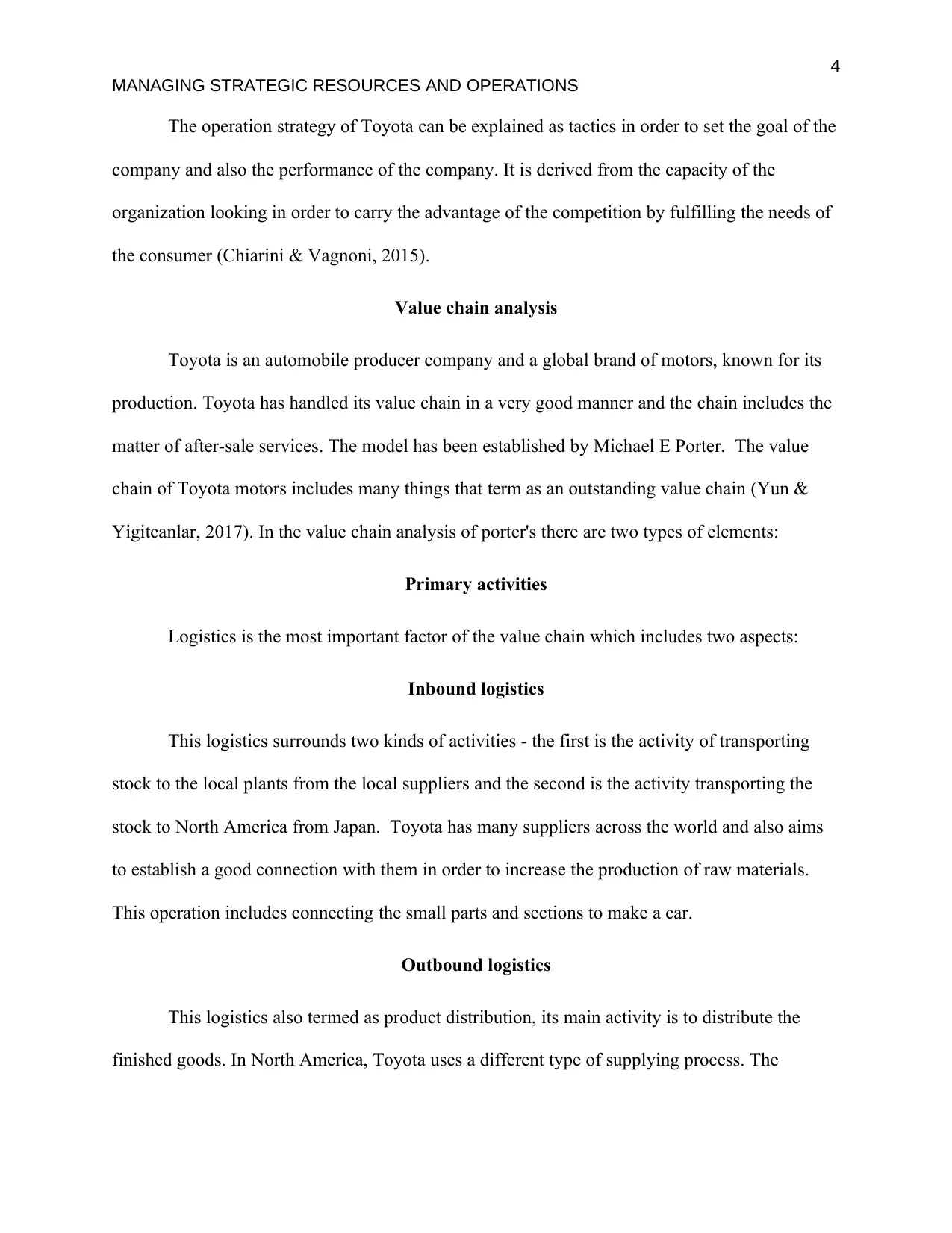
4
MANAGING STRATEGIC RESOURCES AND OPERATIONS
The operation strategy of Toyota can be explained as tactics in order to set the goal of the
company and also the performance of the company. It is derived from the capacity of the
organization looking in order to carry the advantage of the competition by fulfilling the needs of
the consumer (Chiarini & Vagnoni, 2015).
Value chain analysis
Toyota is an automobile producer company and a global brand of motors, known for its
production. Toyota has handled its value chain in a very good manner and the chain includes the
matter of after-sale services. The model has been established by Michael E Porter. The value
chain of Toyota motors includes many things that term as an outstanding value chain (Yun &
Yigitcanlar, 2017). In the value chain analysis of porter's there are two types of elements:
Primary activities
Logistics is the most important factor of the value chain which includes two aspects:
Inbound logistics
This logistics surrounds two kinds of activities - the first is the activity of transporting
stock to the local plants from the local suppliers and the second is the activity transporting the
stock to North America from Japan. Toyota has many suppliers across the world and also aims
to establish a good connection with them in order to increase the production of raw materials.
This operation includes connecting the small parts and sections to make a car.
Outbound logistics
This logistics also termed as product distribution, its main activity is to distribute the
finished goods. In North America, Toyota uses a different type of supplying process. The
MANAGING STRATEGIC RESOURCES AND OPERATIONS
The operation strategy of Toyota can be explained as tactics in order to set the goal of the
company and also the performance of the company. It is derived from the capacity of the
organization looking in order to carry the advantage of the competition by fulfilling the needs of
the consumer (Chiarini & Vagnoni, 2015).
Value chain analysis
Toyota is an automobile producer company and a global brand of motors, known for its
production. Toyota has handled its value chain in a very good manner and the chain includes the
matter of after-sale services. The model has been established by Michael E Porter. The value
chain of Toyota motors includes many things that term as an outstanding value chain (Yun &
Yigitcanlar, 2017). In the value chain analysis of porter's there are two types of elements:
Primary activities
Logistics is the most important factor of the value chain which includes two aspects:
Inbound logistics
This logistics surrounds two kinds of activities - the first is the activity of transporting
stock to the local plants from the local suppliers and the second is the activity transporting the
stock to North America from Japan. Toyota has many suppliers across the world and also aims
to establish a good connection with them in order to increase the production of raw materials.
This operation includes connecting the small parts and sections to make a car.
Outbound logistics
This logistics also termed as product distribution, its main activity is to distribute the
finished goods. In North America, Toyota uses a different type of supplying process. The
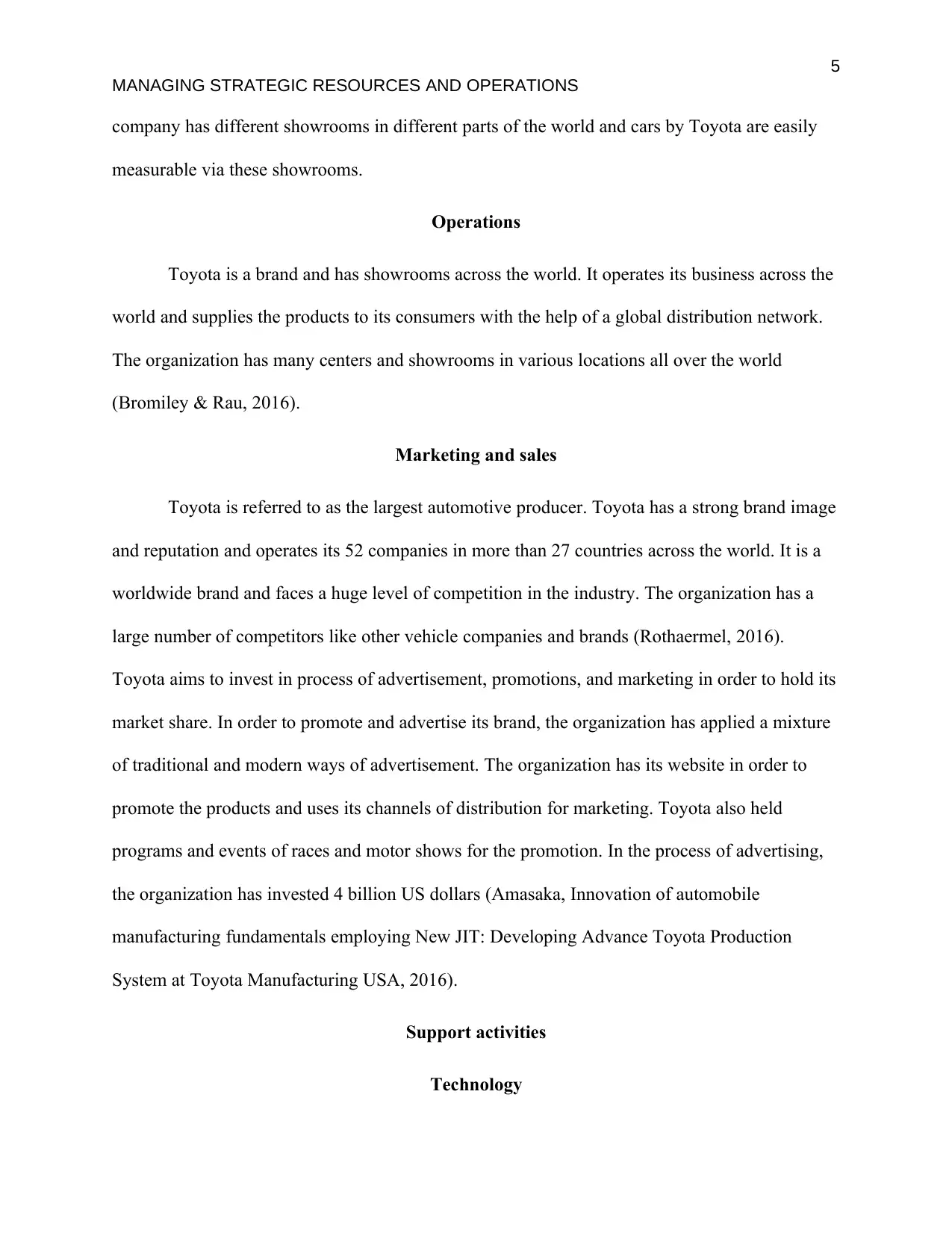
5
MANAGING STRATEGIC RESOURCES AND OPERATIONS
company has different showrooms in different parts of the world and cars by Toyota are easily
measurable via these showrooms.
Operations
Toyota is a brand and has showrooms across the world. It operates its business across the
world and supplies the products to its consumers with the help of a global distribution network.
The organization has many centers and showrooms in various locations all over the world
(Bromiley & Rau, 2016).
Marketing and sales
Toyota is referred to as the largest automotive producer. Toyota has a strong brand image
and reputation and operates its 52 companies in more than 27 countries across the world. It is a
worldwide brand and faces a huge level of competition in the industry. The organization has a
large number of competitors like other vehicle companies and brands (Rothaermel, 2016).
Toyota aims to invest in process of advertisement, promotions, and marketing in order to hold its
market share. In order to promote and advertise its brand, the organization has applied a mixture
of traditional and modern ways of advertisement. The organization has its website in order to
promote the products and uses its channels of distribution for marketing. Toyota also held
programs and events of races and motor shows for the promotion. In the process of advertising,
the organization has invested 4 billion US dollars (Amasaka, Innovation of automobile
manufacturing fundamentals employing New JIT: Developing Advance Toyota Production
System at Toyota Manufacturing USA, 2016).
Support activities
Technology
MANAGING STRATEGIC RESOURCES AND OPERATIONS
company has different showrooms in different parts of the world and cars by Toyota are easily
measurable via these showrooms.
Operations
Toyota is a brand and has showrooms across the world. It operates its business across the
world and supplies the products to its consumers with the help of a global distribution network.
The organization has many centers and showrooms in various locations all over the world
(Bromiley & Rau, 2016).
Marketing and sales
Toyota is referred to as the largest automotive producer. Toyota has a strong brand image
and reputation and operates its 52 companies in more than 27 countries across the world. It is a
worldwide brand and faces a huge level of competition in the industry. The organization has a
large number of competitors like other vehicle companies and brands (Rothaermel, 2016).
Toyota aims to invest in process of advertisement, promotions, and marketing in order to hold its
market share. In order to promote and advertise its brand, the organization has applied a mixture
of traditional and modern ways of advertisement. The organization has its website in order to
promote the products and uses its channels of distribution for marketing. Toyota also held
programs and events of races and motor shows for the promotion. In the process of advertising,
the organization has invested 4 billion US dollars (Amasaka, Innovation of automobile
manufacturing fundamentals employing New JIT: Developing Advance Toyota Production
System at Toyota Manufacturing USA, 2016).
Support activities
Technology
⊘ This is a preview!⊘
Do you want full access?
Subscribe today to unlock all pages.

Trusted by 1+ million students worldwide
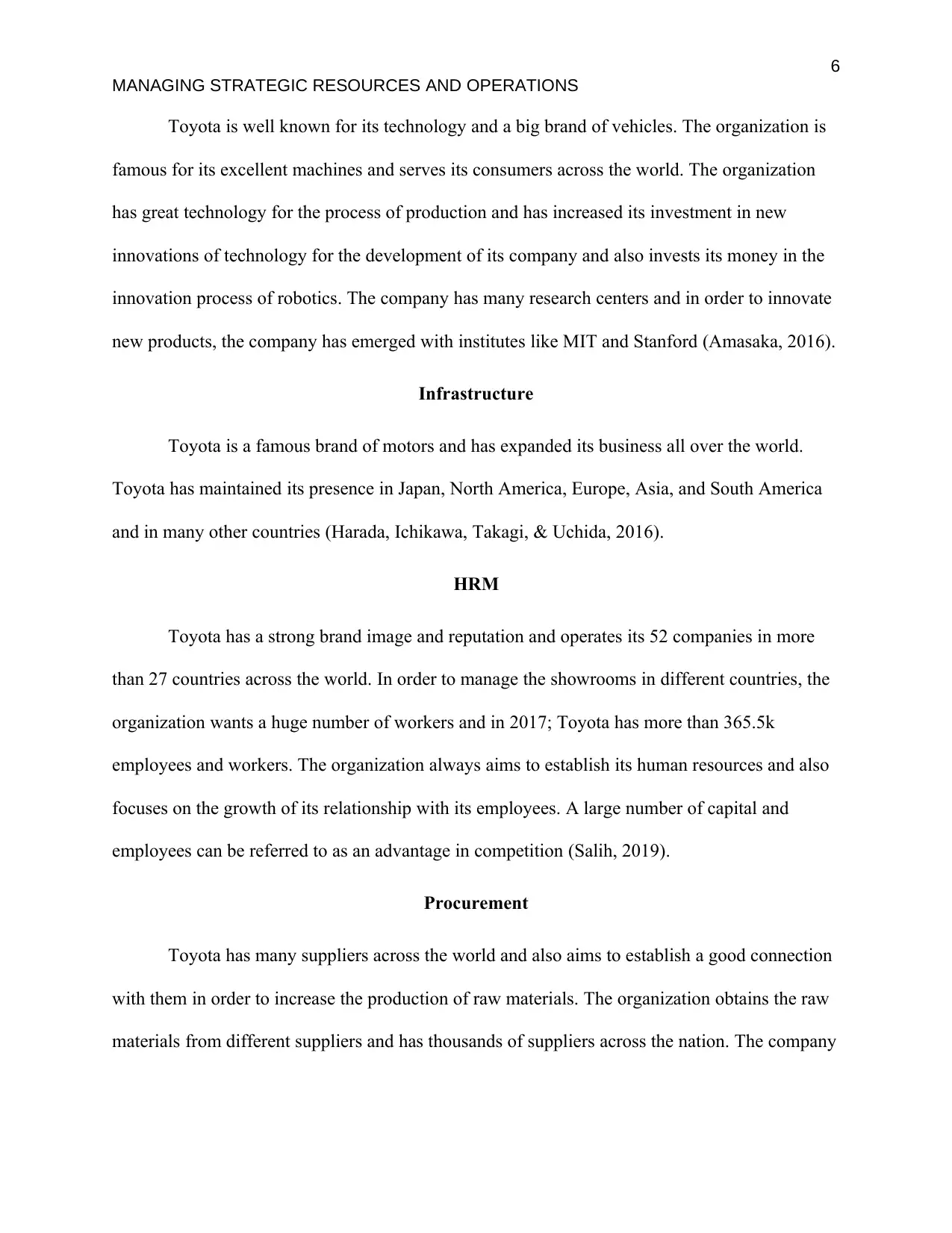
6
MANAGING STRATEGIC RESOURCES AND OPERATIONS
Toyota is well known for its technology and a big brand of vehicles. The organization is
famous for its excellent machines and serves its consumers across the world. The organization
has great technology for the process of production and has increased its investment in new
innovations of technology for the development of its company and also invests its money in the
innovation process of robotics. The company has many research centers and in order to innovate
new products, the company has emerged with institutes like MIT and Stanford (Amasaka, 2016).
Infrastructure
Toyota is a famous brand of motors and has expanded its business all over the world.
Toyota has maintained its presence in Japan, North America, Europe, Asia, and South America
and in many other countries (Harada, Ichikawa, Takagi, & Uchida, 2016).
HRM
Toyota has a strong brand image and reputation and operates its 52 companies in more
than 27 countries across the world. In order to manage the showrooms in different countries, the
organization wants a huge number of workers and in 2017; Toyota has more than 365.5k
employees and workers. The organization always aims to establish its human resources and also
focuses on the growth of its relationship with its employees. A large number of capital and
employees can be referred to as an advantage in competition (Salih, 2019).
Procurement
Toyota has many suppliers across the world and also aims to establish a good connection
with them in order to increase the production of raw materials. The organization obtains the raw
materials from different suppliers and has thousands of suppliers across the nation. The company
MANAGING STRATEGIC RESOURCES AND OPERATIONS
Toyota is well known for its technology and a big brand of vehicles. The organization is
famous for its excellent machines and serves its consumers across the world. The organization
has great technology for the process of production and has increased its investment in new
innovations of technology for the development of its company and also invests its money in the
innovation process of robotics. The company has many research centers and in order to innovate
new products, the company has emerged with institutes like MIT and Stanford (Amasaka, 2016).
Infrastructure
Toyota is a famous brand of motors and has expanded its business all over the world.
Toyota has maintained its presence in Japan, North America, Europe, Asia, and South America
and in many other countries (Harada, Ichikawa, Takagi, & Uchida, 2016).
HRM
Toyota has a strong brand image and reputation and operates its 52 companies in more
than 27 countries across the world. In order to manage the showrooms in different countries, the
organization wants a huge number of workers and in 2017; Toyota has more than 365.5k
employees and workers. The organization always aims to establish its human resources and also
focuses on the growth of its relationship with its employees. A large number of capital and
employees can be referred to as an advantage in competition (Salih, 2019).
Procurement
Toyota has many suppliers across the world and also aims to establish a good connection
with them in order to increase the production of raw materials. The organization obtains the raw
materials from different suppliers and has thousands of suppliers across the nation. The company
Paraphrase This Document
Need a fresh take? Get an instant paraphrase of this document with our AI Paraphraser
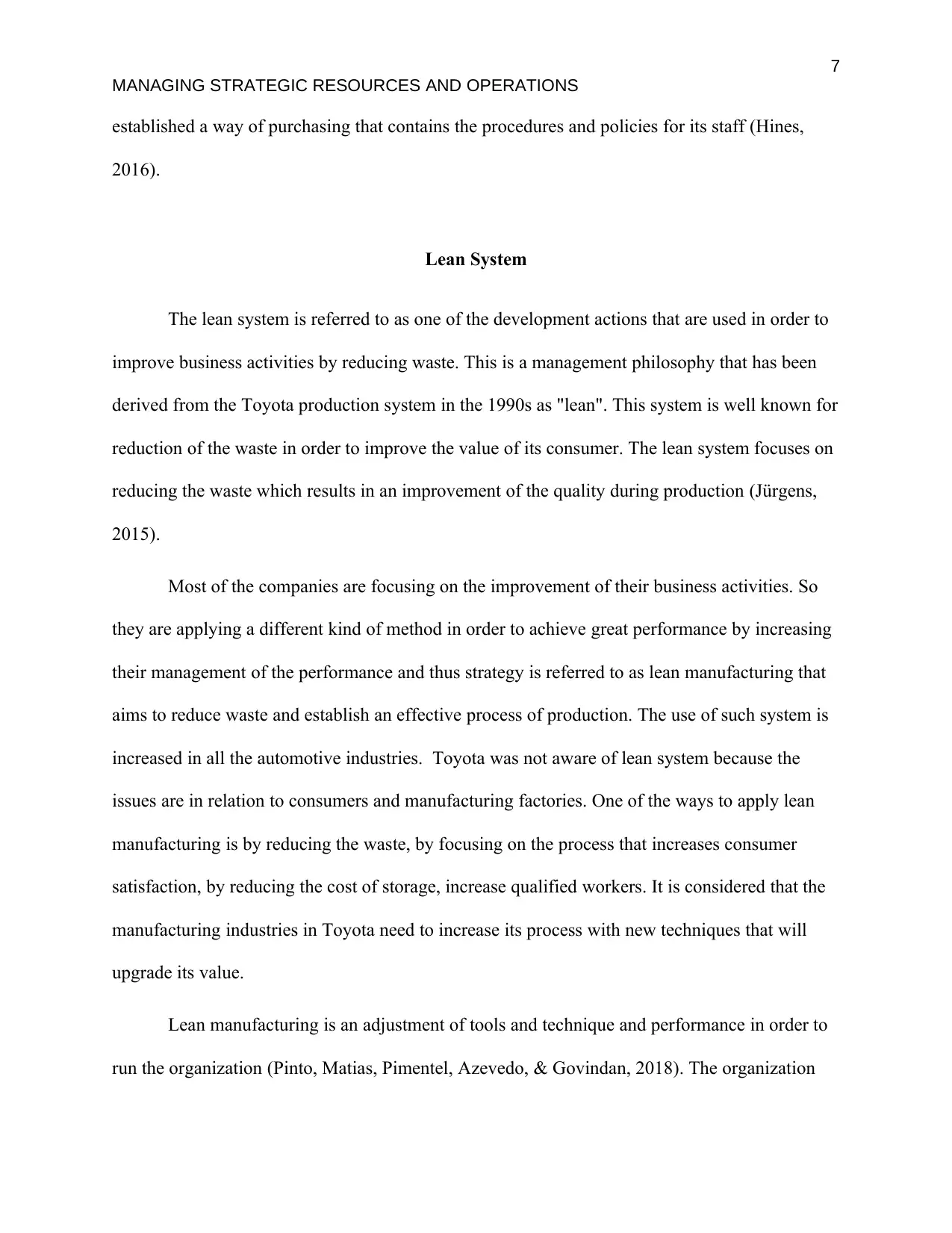
7
MANAGING STRATEGIC RESOURCES AND OPERATIONS
established a way of purchasing that contains the procedures and policies for its staff (Hines,
2016).
Lean System
The lean system is referred to as one of the development actions that are used in order to
improve business activities by reducing waste. This is a management philosophy that has been
derived from the Toyota production system in the 1990s as "lean". This system is well known for
reduction of the waste in order to improve the value of its consumer. The lean system focuses on
reducing the waste which results in an improvement of the quality during production (Jürgens,
2015).
Most of the companies are focusing on the improvement of their business activities. So
they are applying a different kind of method in order to achieve great performance by increasing
their management of the performance and thus strategy is referred to as lean manufacturing that
aims to reduce waste and establish an effective process of production. The use of such system is
increased in all the automotive industries. Toyota was not aware of lean system because the
issues are in relation to consumers and manufacturing factories. One of the ways to apply lean
manufacturing is by reducing the waste, by focusing on the process that increases consumer
satisfaction, by reducing the cost of storage, increase qualified workers. It is considered that the
manufacturing industries in Toyota need to increase its process with new techniques that will
upgrade its value.
Lean manufacturing is an adjustment of tools and technique and performance in order to
run the organization (Pinto, Matias, Pimentel, Azevedo, & Govindan, 2018). The organization
MANAGING STRATEGIC RESOURCES AND OPERATIONS
established a way of purchasing that contains the procedures and policies for its staff (Hines,
2016).
Lean System
The lean system is referred to as one of the development actions that are used in order to
improve business activities by reducing waste. This is a management philosophy that has been
derived from the Toyota production system in the 1990s as "lean". This system is well known for
reduction of the waste in order to improve the value of its consumer. The lean system focuses on
reducing the waste which results in an improvement of the quality during production (Jürgens,
2015).
Most of the companies are focusing on the improvement of their business activities. So
they are applying a different kind of method in order to achieve great performance by increasing
their management of the performance and thus strategy is referred to as lean manufacturing that
aims to reduce waste and establish an effective process of production. The use of such system is
increased in all the automotive industries. Toyota was not aware of lean system because the
issues are in relation to consumers and manufacturing factories. One of the ways to apply lean
manufacturing is by reducing the waste, by focusing on the process that increases consumer
satisfaction, by reducing the cost of storage, increase qualified workers. It is considered that the
manufacturing industries in Toyota need to increase its process with new techniques that will
upgrade its value.
Lean manufacturing is an adjustment of tools and technique and performance in order to
run the organization (Pinto, Matias, Pimentel, Azevedo, & Govindan, 2018). The organization
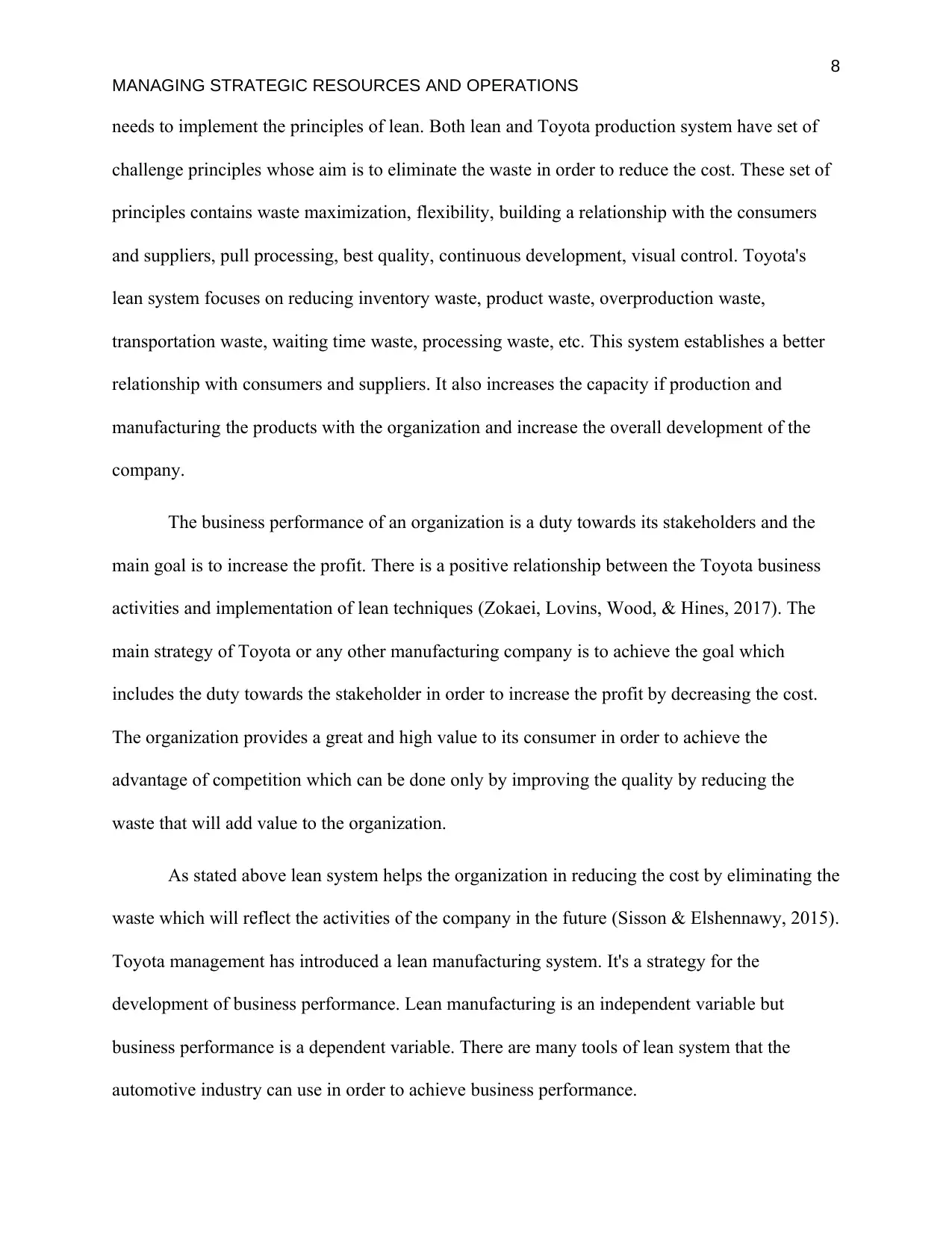
8
MANAGING STRATEGIC RESOURCES AND OPERATIONS
needs to implement the principles of lean. Both lean and Toyota production system have set of
challenge principles whose aim is to eliminate the waste in order to reduce the cost. These set of
principles contains waste maximization, flexibility, building a relationship with the consumers
and suppliers, pull processing, best quality, continuous development, visual control. Toyota's
lean system focuses on reducing inventory waste, product waste, overproduction waste,
transportation waste, waiting time waste, processing waste, etc. This system establishes a better
relationship with consumers and suppliers. It also increases the capacity if production and
manufacturing the products with the organization and increase the overall development of the
company.
The business performance of an organization is a duty towards its stakeholders and the
main goal is to increase the profit. There is a positive relationship between the Toyota business
activities and implementation of lean techniques (Zokaei, Lovins, Wood, & Hines, 2017). The
main strategy of Toyota or any other manufacturing company is to achieve the goal which
includes the duty towards the stakeholder in order to increase the profit by decreasing the cost.
The organization provides a great and high value to its consumer in order to achieve the
advantage of competition which can be done only by improving the quality by reducing the
waste that will add value to the organization.
As stated above lean system helps the organization in reducing the cost by eliminating the
waste which will reflect the activities of the company in the future (Sisson & Elshennawy, 2015).
Toyota management has introduced a lean manufacturing system. It's a strategy for the
development of business performance. Lean manufacturing is an independent variable but
business performance is a dependent variable. There are many tools of lean system that the
automotive industry can use in order to achieve business performance.
MANAGING STRATEGIC RESOURCES AND OPERATIONS
needs to implement the principles of lean. Both lean and Toyota production system have set of
challenge principles whose aim is to eliminate the waste in order to reduce the cost. These set of
principles contains waste maximization, flexibility, building a relationship with the consumers
and suppliers, pull processing, best quality, continuous development, visual control. Toyota's
lean system focuses on reducing inventory waste, product waste, overproduction waste,
transportation waste, waiting time waste, processing waste, etc. This system establishes a better
relationship with consumers and suppliers. It also increases the capacity if production and
manufacturing the products with the organization and increase the overall development of the
company.
The business performance of an organization is a duty towards its stakeholders and the
main goal is to increase the profit. There is a positive relationship between the Toyota business
activities and implementation of lean techniques (Zokaei, Lovins, Wood, & Hines, 2017). The
main strategy of Toyota or any other manufacturing company is to achieve the goal which
includes the duty towards the stakeholder in order to increase the profit by decreasing the cost.
The organization provides a great and high value to its consumer in order to achieve the
advantage of competition which can be done only by improving the quality by reducing the
waste that will add value to the organization.
As stated above lean system helps the organization in reducing the cost by eliminating the
waste which will reflect the activities of the company in the future (Sisson & Elshennawy, 2015).
Toyota management has introduced a lean manufacturing system. It's a strategy for the
development of business performance. Lean manufacturing is an independent variable but
business performance is a dependent variable. There are many tools of lean system that the
automotive industry can use in order to achieve business performance.
⊘ This is a preview!⊘
Do you want full access?
Subscribe today to unlock all pages.

Trusted by 1+ million students worldwide
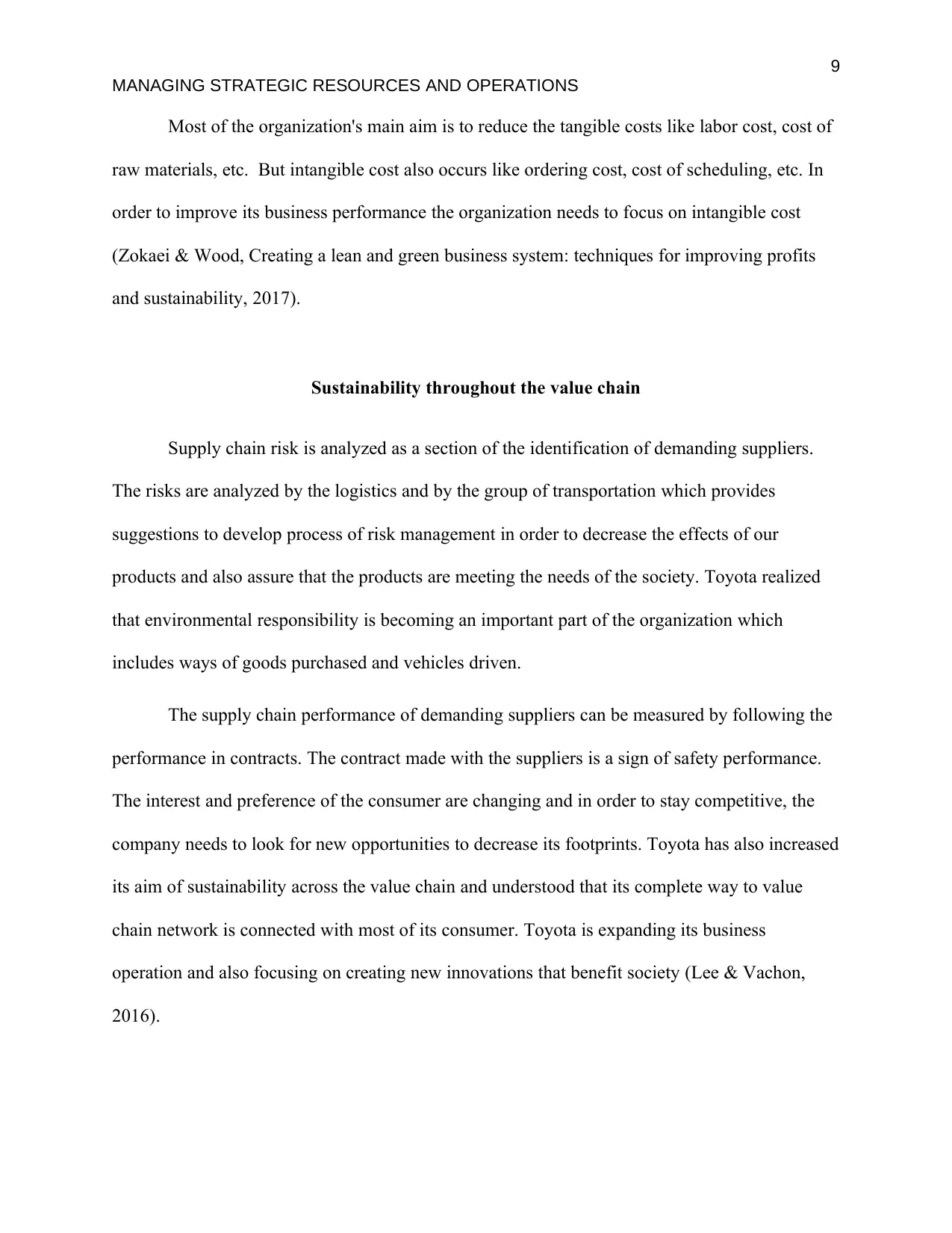
9
MANAGING STRATEGIC RESOURCES AND OPERATIONS
Most of the organization's main aim is to reduce the tangible costs like labor cost, cost of
raw materials, etc. But intangible cost also occurs like ordering cost, cost of scheduling, etc. In
order to improve its business performance the organization needs to focus on intangible cost
(Zokaei & Wood, Creating a lean and green business system: techniques for improving profits
and sustainability, 2017).
Sustainability throughout the value chain
Supply chain risk is analyzed as a section of the identification of demanding suppliers.
The risks are analyzed by the logistics and by the group of transportation which provides
suggestions to develop process of risk management in order to decrease the effects of our
products and also assure that the products are meeting the needs of the society. Toyota realized
that environmental responsibility is becoming an important part of the organization which
includes ways of goods purchased and vehicles driven.
The supply chain performance of demanding suppliers can be measured by following the
performance in contracts. The contract made with the suppliers is a sign of safety performance.
The interest and preference of the consumer are changing and in order to stay competitive, the
company needs to look for new opportunities to decrease its footprints. Toyota has also increased
its aim of sustainability across the value chain and understood that its complete way to value
chain network is connected with most of its consumer. Toyota is expanding its business
operation and also focusing on creating new innovations that benefit society (Lee & Vachon,
2016).
MANAGING STRATEGIC RESOURCES AND OPERATIONS
Most of the organization's main aim is to reduce the tangible costs like labor cost, cost of
raw materials, etc. But intangible cost also occurs like ordering cost, cost of scheduling, etc. In
order to improve its business performance the organization needs to focus on intangible cost
(Zokaei & Wood, Creating a lean and green business system: techniques for improving profits
and sustainability, 2017).
Sustainability throughout the value chain
Supply chain risk is analyzed as a section of the identification of demanding suppliers.
The risks are analyzed by the logistics and by the group of transportation which provides
suggestions to develop process of risk management in order to decrease the effects of our
products and also assure that the products are meeting the needs of the society. Toyota realized
that environmental responsibility is becoming an important part of the organization which
includes ways of goods purchased and vehicles driven.
The supply chain performance of demanding suppliers can be measured by following the
performance in contracts. The contract made with the suppliers is a sign of safety performance.
The interest and preference of the consumer are changing and in order to stay competitive, the
company needs to look for new opportunities to decrease its footprints. Toyota has also increased
its aim of sustainability across the value chain and understood that its complete way to value
chain network is connected with most of its consumer. Toyota is expanding its business
operation and also focusing on creating new innovations that benefit society (Lee & Vachon,
2016).
Paraphrase This Document
Need a fresh take? Get an instant paraphrase of this document with our AI Paraphraser
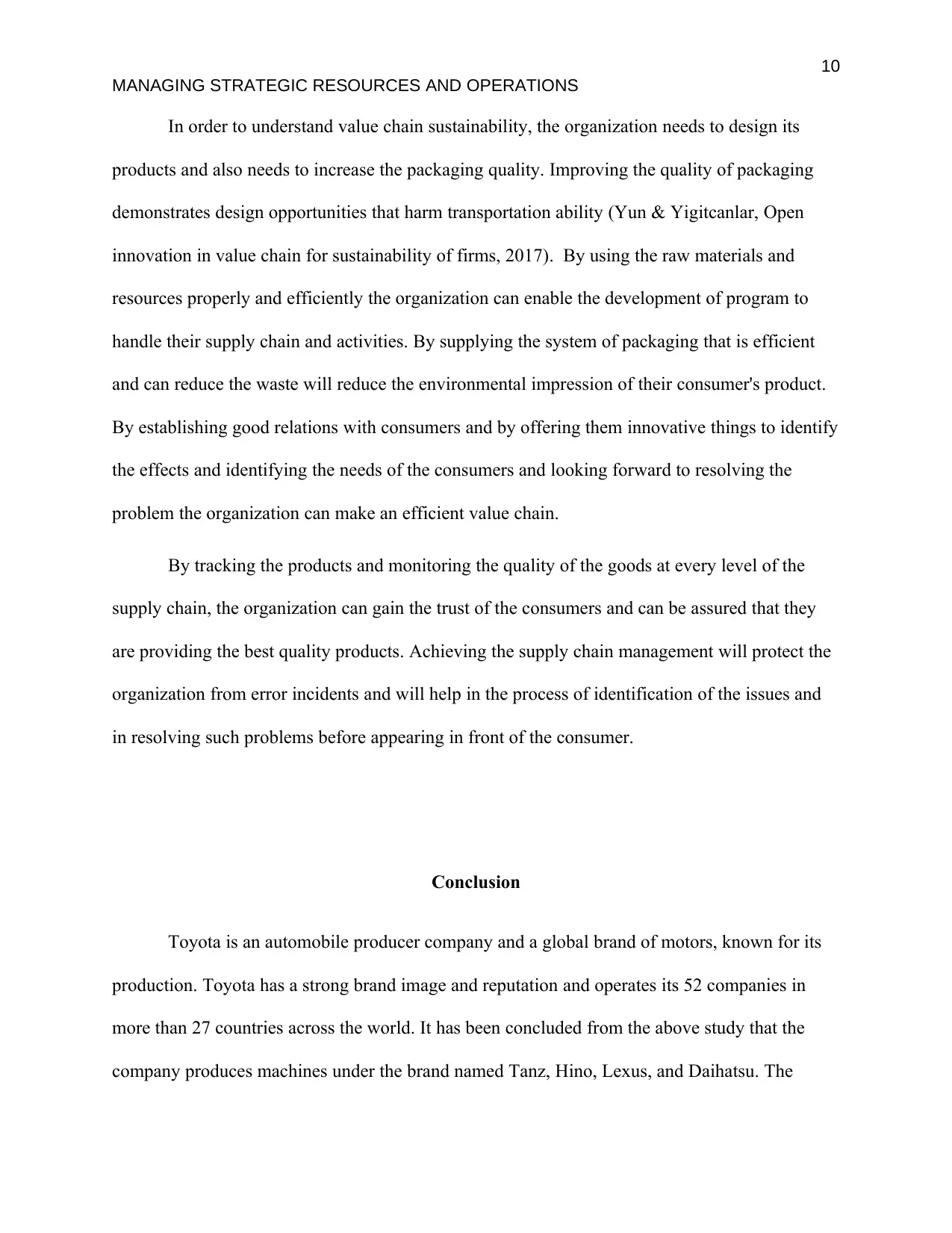
10
MANAGING STRATEGIC RESOURCES AND OPERATIONS
In order to understand value chain sustainability, the organization needs to design its
products and also needs to increase the packaging quality. Improving the quality of packaging
demonstrates design opportunities that harm transportation ability (Yun & Yigitcanlar, Open
innovation in value chain for sustainability of firms, 2017). By using the raw materials and
resources properly and efficiently the organization can enable the development of program to
handle their supply chain and activities. By supplying the system of packaging that is efficient
and can reduce the waste will reduce the environmental impression of their consumer's product.
By establishing good relations with consumers and by offering them innovative things to identify
the effects and identifying the needs of the consumers and looking forward to resolving the
problem the organization can make an efficient value chain.
By tracking the products and monitoring the quality of the goods at every level of the
supply chain, the organization can gain the trust of the consumers and can be assured that they
are providing the best quality products. Achieving the supply chain management will protect the
organization from error incidents and will help in the process of identification of the issues and
in resolving such problems before appearing in front of the consumer.
Conclusion
Toyota is an automobile producer company and a global brand of motors, known for its
production. Toyota has a strong brand image and reputation and operates its 52 companies in
more than 27 countries across the world. It has been concluded from the above study that the
company produces machines under the brand named Tanz, Hino, Lexus, and Daihatsu. The
MANAGING STRATEGIC RESOURCES AND OPERATIONS
In order to understand value chain sustainability, the organization needs to design its
products and also needs to increase the packaging quality. Improving the quality of packaging
demonstrates design opportunities that harm transportation ability (Yun & Yigitcanlar, Open
innovation in value chain for sustainability of firms, 2017). By using the raw materials and
resources properly and efficiently the organization can enable the development of program to
handle their supply chain and activities. By supplying the system of packaging that is efficient
and can reduce the waste will reduce the environmental impression of their consumer's product.
By establishing good relations with consumers and by offering them innovative things to identify
the effects and identifying the needs of the consumers and looking forward to resolving the
problem the organization can make an efficient value chain.
By tracking the products and monitoring the quality of the goods at every level of the
supply chain, the organization can gain the trust of the consumers and can be assured that they
are providing the best quality products. Achieving the supply chain management will protect the
organization from error incidents and will help in the process of identification of the issues and
in resolving such problems before appearing in front of the consumer.
Conclusion
Toyota is an automobile producer company and a global brand of motors, known for its
production. Toyota has a strong brand image and reputation and operates its 52 companies in
more than 27 countries across the world. It has been concluded from the above study that the
company produces machines under the brand named Tanz, Hino, Lexus, and Daihatsu. The
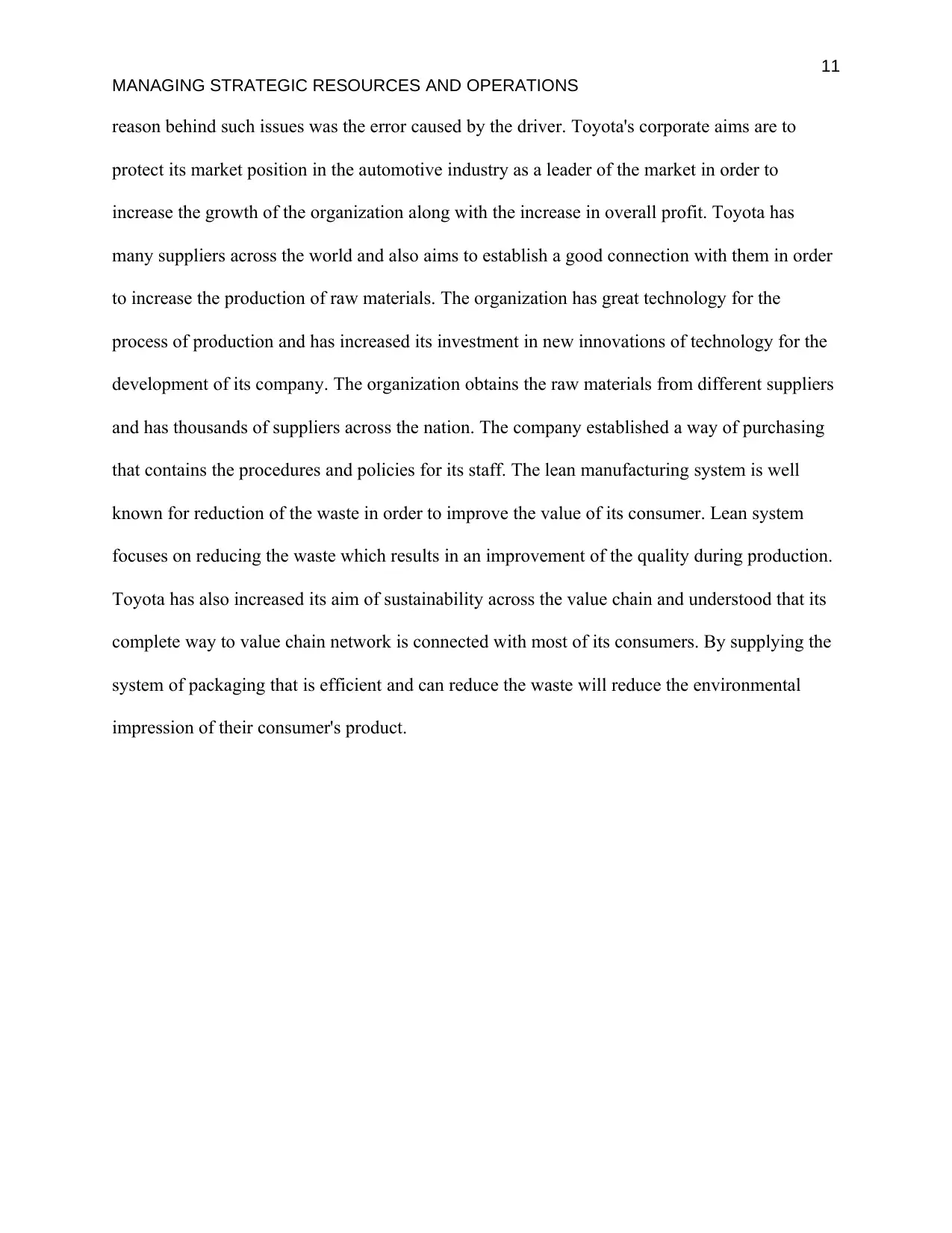
11
MANAGING STRATEGIC RESOURCES AND OPERATIONS
reason behind such issues was the error caused by the driver. Toyota's corporate aims are to
protect its market position in the automotive industry as a leader of the market in order to
increase the growth of the organization along with the increase in overall profit. Toyota has
many suppliers across the world and also aims to establish a good connection with them in order
to increase the production of raw materials. The organization has great technology for the
process of production and has increased its investment in new innovations of technology for the
development of its company. The organization obtains the raw materials from different suppliers
and has thousands of suppliers across the nation. The company established a way of purchasing
that contains the procedures and policies for its staff. The lean manufacturing system is well
known for reduction of the waste in order to improve the value of its consumer. Lean system
focuses on reducing the waste which results in an improvement of the quality during production.
Toyota has also increased its aim of sustainability across the value chain and understood that its
complete way to value chain network is connected with most of its consumers. By supplying the
system of packaging that is efficient and can reduce the waste will reduce the environmental
impression of their consumer's product.
MANAGING STRATEGIC RESOURCES AND OPERATIONS
reason behind such issues was the error caused by the driver. Toyota's corporate aims are to
protect its market position in the automotive industry as a leader of the market in order to
increase the growth of the organization along with the increase in overall profit. Toyota has
many suppliers across the world and also aims to establish a good connection with them in order
to increase the production of raw materials. The organization has great technology for the
process of production and has increased its investment in new innovations of technology for the
development of its company. The organization obtains the raw materials from different suppliers
and has thousands of suppliers across the nation. The company established a way of purchasing
that contains the procedures and policies for its staff. The lean manufacturing system is well
known for reduction of the waste in order to improve the value of its consumer. Lean system
focuses on reducing the waste which results in an improvement of the quality during production.
Toyota has also increased its aim of sustainability across the value chain and understood that its
complete way to value chain network is connected with most of its consumers. By supplying the
system of packaging that is efficient and can reduce the waste will reduce the environmental
impression of their consumer's product.
⊘ This is a preview!⊘
Do you want full access?
Subscribe today to unlock all pages.

Trusted by 1+ million students worldwide
1 out of 15
Related Documents
Your All-in-One AI-Powered Toolkit for Academic Success.
+13062052269
info@desklib.com
Available 24*7 on WhatsApp / Email
![[object Object]](/_next/static/media/star-bottom.7253800d.svg)
Unlock your academic potential
Copyright © 2020–2025 A2Z Services. All Rights Reserved. Developed and managed by ZUCOL.




